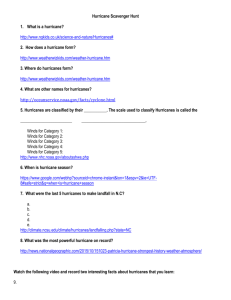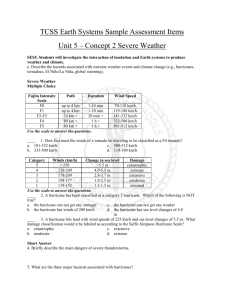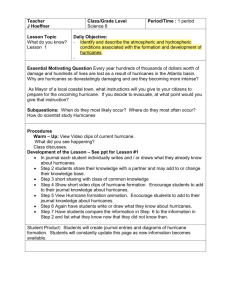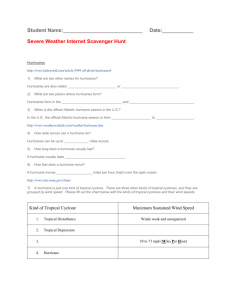Hurricanes Technical Piece
advertisement
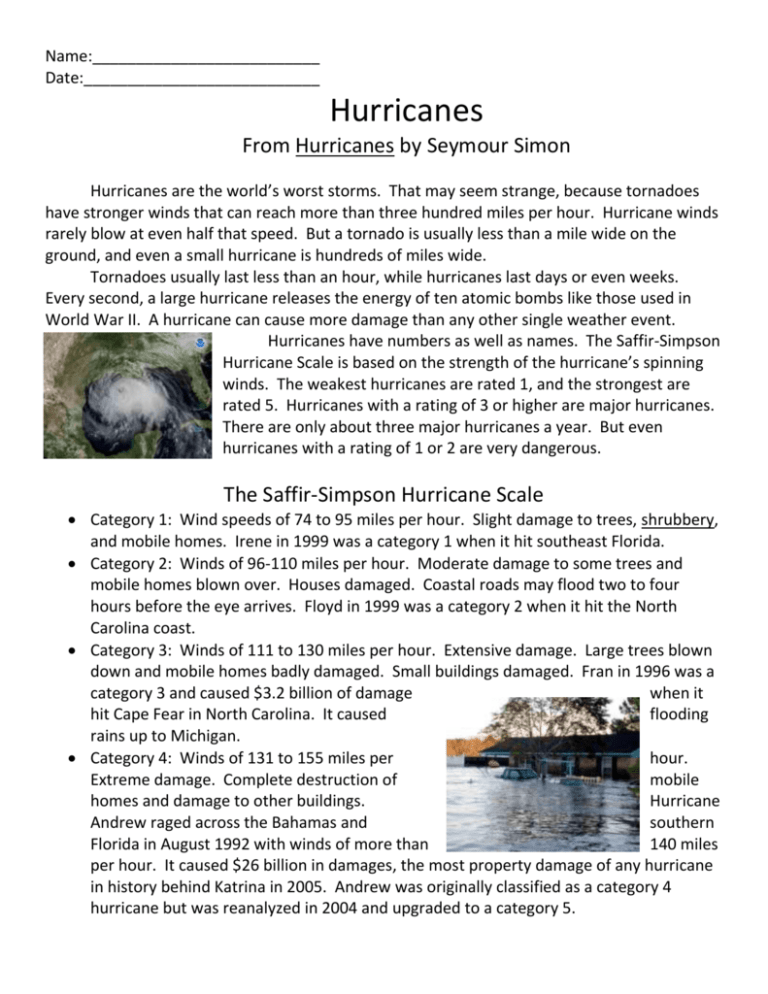
Name:__________________________ Date:___________________________ Hurricanes From Hurricanes by Seymour Simon Hurricanes are the world’s worst storms. That may seem strange, because tornadoes have stronger winds that can reach more than three hundred miles per hour. Hurricane winds rarely blow at even half that speed. But a tornado is usually less than a mile wide on the ground, and even a small hurricane is hundreds of miles wide. Tornadoes usually last less than an hour, while hurricanes last days or even weeks. Every second, a large hurricane releases the energy of ten atomic bombs like those used in World War II. A hurricane can cause more damage than any other single weather event. Hurricanes have numbers as well as names. The Saffir-Simpson Hurricane Scale is based on the strength of the hurricane’s spinning winds. The weakest hurricanes are rated 1, and the strongest are rated 5. Hurricanes with a rating of 3 or higher are major hurricanes. There are only about three major hurricanes a year. But even hurricanes with a rating of 1 or 2 are very dangerous. The Saffir-Simpson Hurricane Scale Category 1: Wind speeds of 74 to 95 miles per hour. Slight damage to trees, shrubbery, and mobile homes. Irene in 1999 was a category 1 when it hit southeast Florida. Category 2: Winds of 96-110 miles per hour. Moderate damage to some trees and mobile homes blown over. Houses damaged. Coastal roads may flood two to four hours before the eye arrives. Floyd in 1999 was a category 2 when it hit the North Carolina coast. Category 3: Winds of 111 to 130 miles per hour. Extensive damage. Large trees blown down and mobile homes badly damaged. Small buildings damaged. Fran in 1996 was a category 3 and caused $3.2 billion of damage when it hit Cape Fear in North Carolina. It caused flooding rains up to Michigan. Category 4: Winds of 131 to 155 miles per hour. Extreme damage. Complete destruction of mobile homes and damage to other buildings. Hurricane Andrew raged across the Bahamas and southern Florida in August 1992 with winds of more than 140 miles per hour. It caused $26 billion in damages, the most property damage of any hurricane in history behind Katrina in 2005. Andrew was originally classified as a category 4 hurricane but was reanalyzed in 2004 and upgraded to a category 5. Category 5: Winds greater than 155 miles per hour. A catastrophe. Complete destruction of mobile homes. Complete failure of some buildings and total destruction of roofs on major residences and industrial buildings. Major flooding. Camille in 1969 was a category 5 with winds as high as 200 miles per hour. About 250 people died because of high winds and flooding in Mississippi, Louisiana, and Virginia. Even after a hurricane passes by, conditions outside may still be dangerous. Here are some tips for you and your family. 1. Keep listening to the radio or television for updates on flooding and highway conditions. Wait until an area is declared safe before going back into it. 2. Stay away from moving water. Rapidly moving water even less than a food deep can sweep you away. If you see water flowing across a street, turn around and go another way. 3. Don’t play in flooded areas. They are dangerous. The water may also be electrically charged from downed or underground power lines. 4. Use a flashlight for emergency lighting. Don’t use a candle or a flame indoor if the power goes off. 5. Use bottled or stored water for drinking and cooking. Use tap water only when local officials say it is safe. 6. Use the telephone only for emergency calls. If someone needs to be rescued or helped, call the police or local officials. By preparing ahead and listening to the radio and following instructions, everyone can be much safe during a hurricane. 1. Which of the following was a hurricane in 1999? A Katrina B Andrew C Camille D Floyd 2. What is the meaning of the word catastrophe? A loud noise B award given to a cat C widespread disaster D home of a king or queen 3. Another name for shrubbery is A small bushes B juicy red fruit C raising your shoulders slightly D cars and trucks 4. According to the passage, what type of weather has winds that reach three hundred miles per hour? A hurricane B tornado C earthquake D thunderstorm 5. Which would be the best place to find more information about hurricanes? A a dictionary B an index C a thesaurus D www.weather.com 6. The author uses jot dots (or bullet points) in the passage to A give the reader a series of steps to follow B help the reader understand the main ideas being presented C divide information into subtopics for the reader D decorate the page The passage lists several ways to stay safe during and after a hurricane. Why is it important to follow these safety rules? Name three safety tips that deal with water. Use information from the passage to support your response. ___________________________________________________________________ ___________________________________________________________________ ___________________________________________________________________ ___________________________________________________________________ ___________________________________________________________________ ___________________________________________________________________ ___________________________________________________________________ ___________________________________________________________________ ___________________________________________________________________ ___________________________________________________________________ ___________________________________________________________________ ___________________________________________________________________ ___________________________________________________________________ ___________________________________________________________________ ___________________________________________________________________ ___________________________________________________________________ ___________________________________________________________________ ___________________________________________________________________ ___________________________________________________________________ ___________________________________________________________________ ___________________________________________________________________


